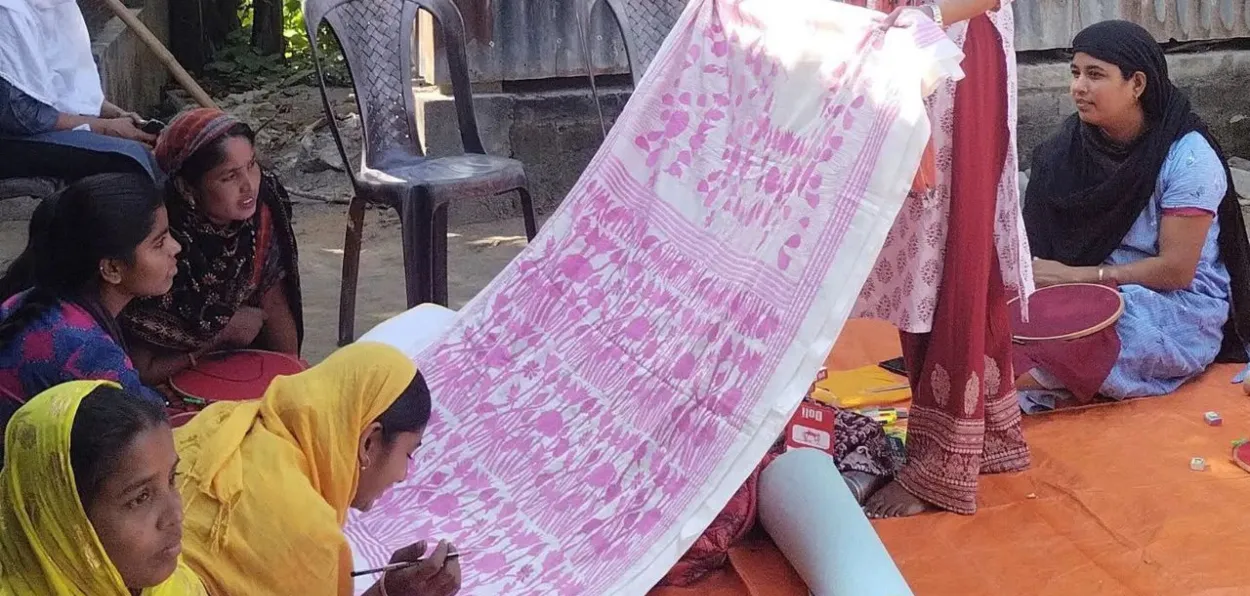
Reshma Rehman
Kantha is traditional embroidery that was on the verge of going extinct until recently. The reason: Kantha embroidery was not commercialized, and the advent of embroidery machines imitated the handcrafted delicate designs and sold at cheaper rates.
Time has taken a turn as the women of Char Chapori, a locality on the banks of the Brahmaputra River in Assam, have vowed to save this art form as it has become their source of livelihood.
This flood-prone zone comprises 4.6 percent of Assam’s total area. Most of the people living here are below the poverty line. Even amidst this bleak scenario, the women are struggling to revive and popularize this Indian art form and to become financially independent.
Assam shares a 127 km border with West Bengal and this embroidery, along with other elements is part of the cross-cultural connections.
Interestingly, the Char Chapori area is mostly inhabited by Bengali-speaking Muslims, though some people are also from other religious denominations.
The living conditions here are pretty bad. Most of the people are uneducated and unskilled and they are into low-paying jobs like farming, animal husbandry, and physical labour.
Most of the houses in Char Chopri are shanties. They have to rebuild their bamboo and mud houses each time floods destroy their dwellings, adding to the cost of living.
However, the women of this area have taken charge to break the cycle of poverty and lack of resources. The women and young girls of Char Chapori have always been adept at creating motifs of Kantha. Women of the families have been making Kantha designs for generations.
The women are experts in stitching colourful thematic Kantha designs on rugs, baby bedding, bed sheets, blankets, sarees, suits, and dupattas at home using old or new clothes.
Besides they also make pillow covers, table covers, wall hangings, etc. to decorate the house.
Hindu women create religious stories that are direct depictions of mythology. Yes, all of them are extremely beautiful and unbelievable to look at, especially in today's age of machinery and AI.
Now, this dying art has started to come alive again and the contribution of Muslim women is important. Its impact is proving to be effective in changing the thinking of the town and society. Amarapari NGO has brought a ray of hope into their lives.
Mulla, the founder of the NGO, has seen their situation closely. He started making masks during the Covid-19 lockdown. He made thousands of masks, which resulted in good income. Gradually orders for masks with matching dresses started coming in, and the number of orders kept increasing.
Orders for various items made from Kantha art kept increasing. Social media platforms like Facebook and Instagram played a very important role in making it popular, due to which a large number of orders come from the country and abroad.
You can check out the Amrapari page. Realizing the mastery of this art, the women thought of bringing it to the market. This idea was like a lifesaver. Today, thousands of women are involved, and some have become famous as artists. Many have taken steps towards becoming entrepreneurs.
The revival of Kanatha has changed the lives of women. Muslim women are victims of additional restrictions because of their religion. The men of the community are patriarchal and domestic violence is rampant.
Physical torture, beatings, domestic quarrels, mental abuse, financial deprivations, early marriage, and early child-bearing are common. Most girls become mothers before the age of 20.
However, Amarpari NGO has brought a ray of hope into the lives of these women who are troubled by poverty and patriarchy.
NGO founder Manjuwara Mulla has seen their situation from close quarters. During the Covid-19 lockdown, she understood the importance of this art of women and thought of bringing it to the market. Today thousands of women are associated with it, some have become famous as artists. Many have taken the step of becoming entrepreneurs.
By joining the Amarpori NGO, women and girls earn 5-10 thousand or more. This amount may seem small but it was enough to make them financially strong.
Also, a steady decline is visible in domestic violence. Due to regular fights, homes had turned into places full of negativity. There has been a significant decline in this. Women have also started contributing financially to the family. The men who had not allowed their wives to join this work are now ferrying their wives to the factory.
The interesting thing is that many men have started helping with household chores. They have started happily taking the responsibility of taking care of the children when their wives go to work. This is a positive thing.
(Dr. Reshma Rahman is an Assistant Professor and Researcher, USTM, Meghalaya.)
